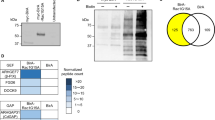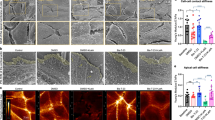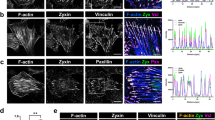Abstract
The glomerular filtration barrier in the kidney is formed in part by a specialized intercellular junction known as the slit diaphragm, which connects adjacent actin-based foot processes of kidney epithelial cells (podocytes)1. Mutations affecting a number of slit diaphragm proteins, including nephrin (encoded by NPHS1)2, lead to renal disease owing to disruption of the filtration barrier and rearrangement of the actin cytoskeleton3, although the molecular basis for this is unclear. Here we show that nephrin selectively binds the Src homology 2 (SH2)/SH3 domain-containing Nck adaptor proteins4, which in turn control the podocyte cytoskeleton in vivo. The cytoplasmic tail of nephrin has multiple YDxV sites that form preferred binding motifs for the Nck SH2 domain once phosphorylated by Src-family kinases. We show that this Nck–nephrin interaction is required for nephrin-dependent actin reorganization. Selective deletion of Nck from podocytes of transgenic mice results in defects in the formation of foot processes and in congenital nephrotic syndrome. Together, these findings identify a physiological signalling pathway in which nephrin is linked through phosphotyrosine-based interactions to Nck adaptors, and thus to the underlying actin cytoskeleton in podocytes. Simple and widely expressed SH2/SH3 adaptor proteins can therefore direct the formation of a specialized cellular morphology in vivo.
This is a preview of subscription content, access via your institution
Access options
Subscribe to this journal
Receive 51 print issues and online access
$199.00 per year
only $3.90 per issue
Buy this article
- Purchase on Springer Link
- Instant access to full article PDF
Prices may be subject to local taxes which are calculated during checkout




Similar content being viewed by others
References
Pavenstadt, H., Kriz, W. & Kretzler, M. Cell biology of the glomerular podocyte. Physiol. Rev. 83, 253–307 (2003)
Kestila, M. et al. Positionally cloned gene for a novel glomerular protein—nephrin—is mutated in congenital nephrotic syndrome. Mol. Cell 1, 575–582 (1998)
Oh, J., Reiser, J. & Mundel, P. Dynamic (re)organization of the podocyte actin cytoskeleton in the nephrotic syndrome. Pediatr. Nephrol. 19, 130–137 (2004)
Buday, L., Wunderlich, L. & Tamas, P. The Nck family of adapter proteins: regulators of actin cytoskeleton. Cell. Signal. 14, 723–731 (2002)
Ruotsalainen, V. et al. Nephrin is specifically located at the slit diaphragm of glomerular podocytes. Proc. Natl Acad. Sci. USA 96, 7962–7967 (1999)
Benzing, T. Signaling at the slit diaphragm. J. Am. Soc. Nephrol. 15, 1382–1391 (2004)
Shih, N. Y. et al. Congenital nephrotic syndrome in mice lacking CD2-associated protein. Science 286, 312–315 (1999)
Roselli, S. et al. Early glomerular filtration defect and severe renal disease in podocin-deficient mice. Mol. Cell. Biol. 24, 550–560 (2004)
Lehtonen, S. et al. Cell junction-associated proteins IQGAP1, MAGI-2, CASK, spectrins, and α-actinin are components of the nephrin multiprotein complex. Proc. Natl Acad. Sci. USA 102, 9814–9819 (2005)
Verma, R. et al. Fyn binds to and phosphorylates the kidney slit diaphragm component Nephrin. J. Biol. Chem. 278, 20716–20723 (2003)
Li, H., Lemay, S., Aoudjit, L., Kawachi, H. & Takano, T. SRC-family kinase Fyn phosphorylates the cytoplasmic domain of nephrin and modulates its interaction with podocin. J. Am. Soc. Nephrol. 15, 3006–3015 (2004)
Lahdenpera, J. et al. Clustering-induced tyrosine phosphorylation of nephrin by Src family kinases. Kidney Int. 64, 404–413 (2003)
Yu, C. C., Yen, T. S., Lowell, C. A. & DeFranco, A. L. Lupus-like kidney disease in mice deficient in the Src family tyrosine kinases Lyn and Fyn. Curr. Biol. 11, 34–38 (2001)
Putaala, H., Sainio, K., Sariola, H. & Tryggvason, K. Primary structure of mouse and rat nephrin cDNA and structure and expression of the mouse gene. J. Am. Soc. Nephrol. 11, 991–1001 (2000)
Huber, T. B. et al. Nephrin and CD2AP associate with phosphoinositide 3-OH kinase and stimulate AKT-dependent signaling. Mol. Cell. Biol. 23, 4917–4928 (2003)
Chen, M. et al. Identification of Nck family genes, chromosomal localization, expression, and signaling specificity. J. Biol. Chem. 273, 25171–25178 (1998)
Gruenheid, S. et al. Enteropathogenic E. coli Tir binds Nck to initiate actin pedestal formation in host cells. Nature Cell Biol. 3, 856–859 (2001)
Lu, W., Katz, S., Gupta, R. & Mayer, B. J. Activation of Pak by membrane localization mediated by an SH3 domain from the adaptor protein Nck. Curr. Biol. 7, 85–94 (1997)
Rohatgi, R., Nollau, P., Ho, H. Y., Kirschner, M. W. & Mayer, B. J. Nck and phosphatidylinositol 4,5-bisphosphate synergistically activate actin polymerization through the N-WASP-Arp2/3 pathway. J. Biol. Chem. 276, 26448–26452 (2001)
Bladt, F. et al. The murine Nck SH2/SH3 adaptors are important for the development of mesoderm-derived embryonic structures and for regulating the cellular actin network. Mol. Cell. Biol. 23, 4586–4597 (2003)
Rivera, G. M., Briceno, C. A., Takeshima, F., Snapper, S. B. & Mayer, B. J. Inducible clustering of membrane-targeted SH3 domains of the adaptor protein Nck triggers localized actin polymerization. Curr. Biol. 14, 11–22 (2004)
Putaala, H., Soininen, R., Kilpelainen, P., Wartiovaara, J. & Tryggvason, K. The murine nephrin gene is specifically expressed in kidney, brain and pancreas: inactivation of the gene leads to massive proteinuria and neonatal death. Hum. Mol. Genet. 10, 1–8 (2001)
Rantanen, M. et al. Nephrin TRAP mice lack slit diaphragms and show fibrotic glomeruli and cystic tubular lesions. J. Am. Soc. Nephrol. 13, 1586–1594 (2002)
Donoviel, D. B. et al. Proteinuria and perinatal lethality in mice lacking NEPH1, a novel protein with homology to NEPHRIN. Mol. Cell. Biol. 21, 4829–4836 (2001)
Ciani, L., Patel, A., Allen, N. D. & ffrench-Constant, C. Mice lacking the giant protocadherin mFAT1 exhibit renal slit junction abnormalities and a partially penetrant cyclopia and anophthalmia phenotype. Mol. Cell Biol. 23, 3575–3582 (2003)
Kreidberg, J. A. et al. Alpha 3 beta 1 integrin has a crucial role in kidney and lung organogenesis. Development 122, 3537–3547 (1996)
Kaplan, J. M. et al. Mutations in ACTN4, encoding α-actinin-4, cause familial focal segmental glomerulosclerosis. Nature Genet. 24, 251–256 (2000)
Welsch, T., Endlich, N., Kriz, W. & Endlich, K. CD2AP and p130Cas localize to different F-actin structures in podocytes. Am. J. Physiol. Renal Physiol. 281, F769–F777 (2001)
Kos, C. H. et al. Mice deficient in α-actinin-4 have severe glomerular disease. J. Clin. Invest. 111, 1683–1690 (2003)
Frischknecht, F. et al. Actin-based motility of vaccinia virus mimics receptor tyrosine kinase signalling. Nature 401, 926–929 (1999)
Acknowledgements
We thank T. Huber, G. Rivera, B. Mayer, P. Mundel, P. Soriano, M. Kirschner, K. Tryggvason and D. Hedley for providing reagents and technical advice, D. Holmyard for electron microscopy, and N. Woody for technical contributions. N.J. was supported by fellowships from the Canadian Institutes for Health Research (CIHR) and the National Cancer Institute of Canada (NCIC), with funds from the Terry Fox Run. This work was supported by grants from the CIHR (to S.S.-C.L., T.T., S.E.Q. and T.P.), the NCIC (to S.S.-C.L., S.E.Q. and T.P.) and the Kidney Foundation of Canada (to T.T.). S.S.-C.L. is an NCIC Scientist with funds from the Canadian Cancer Society. L.L. and T.T. hold scholarships from the Fonds de la Recherche en Santé du Québec. S.E.Q. holds a Tier 2 Canada Research Chair. T.P. is a Distinguished Investigator of the CIHR.
Author information
Authors and Affiliations
Corresponding author
Ethics declarations
Competing interests
Reprints and permissions information is available at npg.nature.com/reprintsandpermissions. The authors declare no competing financial interests.
Supplementary information
Supplementary Figure 1
This figure shows expression of Nck1 and Nck2 in podocytes (by lacZ staining and immunoblotting) as well as the presence of mature foot processes in mice lacking either Nck1 or Nck2. The specificity of Podocin-Cre is shown using the Z/EG reporter strain. (PDF 12859 kb)
Supplementary Figure 2
This figure shows that weaning age mice lacking Nck1 and Nck2 in podocytes are less robust than littermates and display massive albuminuria. (PDF 3882 kb)
Supplementary Figure 3
This figure shows by RNA in situ hybridization analysis of glomeruli that podocytes are progressively lost in mice lacking Nck1 and Nck2 expression in podocytes. (PDF 4436 kb)
Supplementary Figure 4
This figure shows by immunoblotting that N-WASp is recruited to phosphorylated Nephrin containing Nck binding sites. (PDF 695 kb)
Supplementary Figure 5
This figure shows by immunoblotting that Src family kinase activity is required to induce tyrosine phosphorylation of Nephrin. (PDF 1719 kb)
Supplementary Methods
This file contains additional details of the methods used in this study. This file also contains additional references. (DOC 33 kb)
Rights and permissions
About this article
Cite this article
Jones, N., Blasutig, I., Eremina, V. et al. Nck adaptor proteins link nephrin to the actin cytoskeleton of kidney podocytes. Nature 440, 818–823 (2006). https://doi.org/10.1038/nature04662
Received:
Accepted:
Published:
Issue Date:
DOI: https://doi.org/10.1038/nature04662
This article is cited by
-
Liquid–liquid phase separation in Alzheimer’s disease
Journal of Molecular Medicine (2024)
-
Distinct Requirements for Adaptor Proteins NCK1 and NCK2 in Mammary Gland Development
Journal of Mammary Gland Biology and Neoplasia (2023)
-
Glycosphingolipid GM3 prevents albuminuria and podocytopathy induced by anti-nephrin antibody
Scientific Reports (2022)
-
The role of protein tyrosine phosphatase 1B (PTP1B) in the pathogenesis of type 2 diabetes mellitus and its complications
Journal of Physiology and Biochemistry (2022)
-
Slit diaphragm maintenance requires dynamic clathrin-mediated endocytosis facilitated by AP-2, Lap, Aux and Hsc70-4 in nephrocytes
Cell & Bioscience (2021)
Comments
By submitting a comment you agree to abide by our Terms and Community Guidelines. If you find something abusive or that does not comply with our terms or guidelines please flag it as inappropriate.



